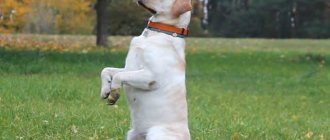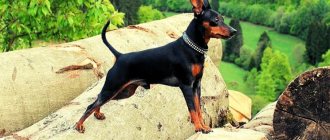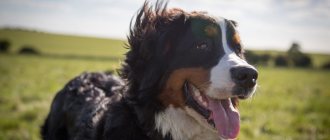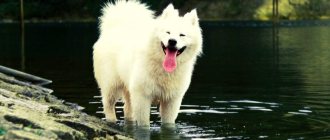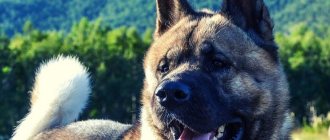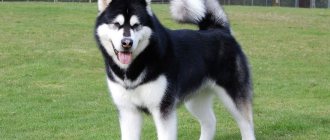Dogs grow and develop very quickly. From the moment of birth to the formation of an adult dog, about a year passes. Therefore, it is very important to know how the puppy develops month by month in the first year of life, what stages of socialization it goes through. This will help ensure proper care, good physical health and upbringing.
First two weeks
Puppies are completely dependent on their mother for the first two weeks. Immediately after birth and in the next few days, they still do not see or hear. Their movement is based on reflexes - they only look for a source of heat, which is the bitch, in order to eat. At this stage, the person's role is to monitor the feeding process.
All babies should have equal access to nipples. This is very important when the litter is large and there are not enough nipples for all the babies. As a rule, the stronger ones start feeding first, and those who are weaker may simply not have enough milk.
Experienced breeders advise dividing puppies into two groups and applying the weaker ones to the nipples first.
In addition, it is necessary to ensure optimal temperature conditions for the bitch with a litter. Babies have very poor thermoregulation and can become hypothermic. It is best to prepare a “house” with a convertible top for a dog family. This design allows easy access and allows you to regulate the temperature inside.
Make sure that the bitch does not accidentally crush the babies during sleep or that they do not crawl far away from her. Puppies should not be separated from their mother for several days after birth; it is best not to disturb them. Too much attention can irritate the bitch, and babies don't need human contact yet. Only in the second week can you gently stroke them or pick them up.
Important: do not take puppies away from the bitch for a long time.
The third and fourth weeks - the beginning of socialization
In the third week of life, puppies already see well and are already beginning to hear. They are still dependent on their mother and feed only on her milk, but they are already starting to play with their brothers and sisters, trying to lick and bite different objects.
During this period, their baby teeth appear. Puppies test their severity on their siblings, biting each other as they play.
This is a natural behavior through which they learn to play with other animals without harming them.
At this stage of development, the puppy's contact with people becomes very important. The dog needs to be petted and picked up. This must be done carefully and make sure that the kids have only pleasant emotions.
If a puppy is separated from his dam and siblings at this stage of his life, he may become overly aggressive in the future and have difficulty interacting with other animals. In turn, the lack of human contact or the presence of negative stimuli that cause anxiety and pain can make an adult dog fearful or not receptive to affection.
Stages of sleep
Dog sleep is similar in structure to human sleep and goes through several stages:
- Nap. The dog doesn't want to sleep, but he needs rest. Therefore, he lies down, closes his eyes and plunges into a state on the verge of sleep and wakefulness. He can hear everything that is happening around him, and at any moment he is ready to jump up.
- Shallow sleep. If the dog feels tired, it lies down and falls into a shallow sleep. The body relaxes and regains strength, but a loud sound can easily snap it out of this state.
- Deep dream. After some time, if not disturbed, the dog sinks deeper and enters the stage of deep, dreamless sleep. He is relaxed, his body is motionless, he sniffles or even snores.
- Quick sleep. After some time, deep sleep turns into rapid sleep - this is the stage of dreams when the brain is activated and processes the impressions received. The dog twitches its paws, its eyes move under its eyelids, sometimes it whines or barks, wags its tail, and changes its position. The duration of this stage is short.
Deep and fast phases replace each other, like in humans. If one of them is missing, the animal will not truly rest.
Weeks 5 and 6 - Play and Learn
The puppy continues to actively develop. During this period, he begins to grow quickly, willingly makes his first “forays” from his mother, and learns about the world. He is curious, full of energy and craves entertainment. Each puppy needs a lot of attention - this is the only way to ensure that in the future he will not have problems communicating with people.
Around the sixth week, after sleeping and eating, it is worth placing the puppies in a specially designated area where they can take care of their physiological needs (although it is still too early for them to walk on their own).
Some breeders give away puppies as early as six weeks of age. However, this is too early - an animal at this stage of development still needs mother's milk and the company of its relatives.
The seventh and eighth weeks - the beginning of independence
At the turn of the seventh and eighth weeks (the exact time depends on the breed), the dog begins to become independent. He may already be taking food other than his mother's milk. At this stage, the puppy’s development has already reached the stage where it can be given to a new owner.
It is believed that it is best to give puppies away at 8-11 weeks of age. During this period, they easily adapt to new conditions.
You should spend a lot of time with your dog at this stage of development. First of all, he should be taught hygiene. If possible, immediately after sleeping or eating, take him outside and sit him on the grass so that he has the opportunity to go to the toilet.
The time for full training has not yet come, but the general rules of behavior need to be explained. If, for example, you do not want your dog to climb on the bed in the future, never put your puppy on it.
The main rule is never allow a puppy to do anything that is prohibited for an adult dog!
In the first days after being separated from his canine family, the baby will be very bored. Therefore, he needs to pay a lot of attention. Make sure his place is warm, with a soft blanket and some sort of toy he can cuddle. Be prepared for the fact that in the first nights he will “cry” and look for his mother’s warm side. In this case, a heating pad or a water bottle wrapped in a towel will help.
To reduce the trauma of separation, breeders give the puppies along with his favorite toy, which still has a “native smell” on it. This makes the dog feel safer.
Life without a mother: nutrition from birth
When can you take your puppy outside for walks after the first vaccination?
Being close to its mother, the puppy, no matter whether it is a mongrel or a purebred individual, receives her milk, which contains all the useful substances and vitamins for proper development. But when moving to a new home, providing the food ration falls on the owner’s shoulders, because it should be no worse than what his mother fed the pet. Therefore, it is important to decide what the dog’s food will be - natural or industrial.
Note! Natural nutrition is based on fermented milk, meat products, and fiber. Industrial food includes the necessary amount of vitamins for adequate feeding of a puppy, and can be purchased at any store.
Is it possible to mix natural and industrial food?
Mixing natural and industrial food is strictly prohibited. Some owners do this to make the food more nutritious, but this action can cause serious harm to the pet's health.
The type of food must be selected by the owner, but they cannot be mixed
The third month is the intensive development of the puppy
Around the ninth - eleventh week, the dog remembers everything very easily. This is the best time to start training. The baby strives to understand the world around him; he, like a sponge, absorbs all the information and quickly learns everything. And he does it with pleasure, perceiving it as an entertaining game.
When training your dog, never use a system of punishment for unwanted behavior. The physical punishment and pain that the puppy feels can remain in his memory for the rest of his life. This will affect his attitude towards the owner and people in general.
The owner's requirements must be consistent and understandable, otherwise the animal will not learn the rules of the house. You can now take your baby with you for a walk. During which you need to stroke him often and play with him. Training sessions should not be long in time. Focus on your pet. Work on teaching commands as long as he is focused. Always reward your student for every exercise performed correctly.
What are social skills for?
There are many manuals on raising puppies for dummies. Of course, you can glean useful information from each source, but do not forget that each pet is individual, with its own characteristics, therefore, the approach must be individual.
Raising and training a dog are important stages in the life of the owner and the dog.
Before you figure out how to raise a puppy, you need to understand why an animal needs social skills. Social skills allow your pet to become an intelligent family member who:
- will be a faithful friend and guard;
- will relieve himself in the right place;
- will calmly receive guests;
- will not spoil things and steal food;
And so the list can go on ad infinitum.
Puppy development in the fourth month - hierarchy phase
A puppy at the twelfth or thirteenth week of life will chew everything that gets into its teeth. The best way to protect shoes and furniture is to give him access to the right toys and teethers. During this period, there is already a close connection between him and the owner. Despite this, the dog may try to test his owner's patience: for example, by running away during a walk or ignoring orders. Firmness, calmness, consistency and regular training are the keys to taming the dog’s temperament and showing him who is the leader in the “house pack”.
The dog by its nature is a herd animal, so it is imperative to establish a hierarchy. Clear rules must be established and followed. When issuing commands, it's not so much the volume as the tone of voice. In addition, short commands should be combined with clear gestures. Always use a specific command and gesture combination.
If the dog was raised for up to three months with its relatives, the hierarchy has already been established. If he was excommunicated earlier, and he lives only surrounded by people, then he will definitely fight with them for power. During this time, clear boundaries must be set and respected if you want to have authority over the puppy.
As a dog owner, you must remain adamant when he wants to take over people.
Don't let your pet lie on the couch, walk through the door in front of you, or hang around you waiting for food. Make it clear to your dog what you expect from him and put him in his place. Consistency and distancing with dividers is extremely important. Your pet will understand that you are the leader of the pack and will happily obey the established rules.
The “Come to me” command on a walk
When, while walking, the puppy moves away from you at a distance of 7-8 steps, call him. Did the dog pay attention to you? Command “Come to me.” When your puppy approaches you, praise him, pet him and give him a treat. You need to repeat this exercise about 5 times.
Does your puppy not respond to its name? Repeat it, get attention. Give the command “Come to me” in a louder and more commanding tone. Then show the puppy the treat. Remember that shouting commands and nicknames is prohibited!
Does your puppy continue to ignore commands? Call him, quickly step aside or sit down. This should interest the puppy and he will come to you. Now you can praise him, treat him and pet him.
5-6 months - environmental awareness
At this time, the dog begins to expand its living space and remember it. Now you need to consolidate the previously learned rules of communication and behavior. If the baby was separated from its mother at the age of 3-4 months, then it has well learned species-specific social behavior. He knows well how to behave with adult animals, when to play and when not to. Can “read” the sign language of its relatives. All that remains is to secure it.
If the puppy was taken early, the owner himself must teach him the rules of behavior with other dogs. Under no circumstances should it be isolated. He must communicate with his own kind. Socialization is a very important stage. If you miss it, it may affect the psychological state of the mature dog. This can be expressed in fearfulness or aggression at the sight of strange animals, in panic or depression in the absence of the owner. Between 5 and 6 months the dog becomes independent and requires a firm hand to get through the rebellious period of puberty.
Growing period: 1–2 years
After a year of life, the development of puppies slows down. The dog becomes sexually mature at approximately 12 months, at which time it can be switched to adult food. She already knows who her “pack” is, distinguishes strangers from familiar people. The dog tries to aggressively show leadership and impose its will on its owner. Stop this behavior and continue training.
Each stage of a puppy’s growth affects its behavior and character development. If you want to raise a physically and mentally healthy dog, participate in its life, love and take care of it.
